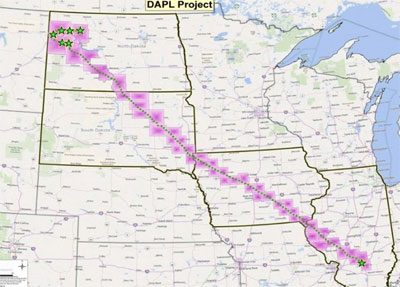While the media ignores it, thousands of people are protesting yet another massive pipeline today – this time the Dakota Access Pipeline.
Find an event near you. 3000 people are protesting at Standing Rock Sioux reservation and events are being held in 100 cities. Sen. Bernie Sanders is holding a rally at the White House.
From the Bakken fracked oil fieds in North Dakota, the $3.8 billion pipeline would travel 1,168 miles through South Dakota, Iowa, and Illinois and under the Missouri River – just upstream from Standing Rock Sioux’s drinking water supply. Up to 570,000 barrels of volatile fracked oil would course through every day on its way to an Illinois distribution hub.
From there, trains carry it to East Coast refineries and it connects with Continental Resources’s Energy Transfer Crude Oil Pipeline (ETCOP) line, which travels 750 miles to a refinery along the Texas Gulf.
Incredibly, this network would carry over 50% of North Dakota’s current oil production.
Similar in length and density to the rejected Keystone pipeline, the inevitable ruptures and spills put tribal land, wildlife habitat, water resources and farms at risk. It cuts through ancestral lands of Standing Rock Sioux and within half a mile of their reservation. And it keeps the US addicted to fossil fuels.
How much fossil fuels? It will equal the annual emissions of 30 coal plants (21.4 million cars), says Oil Change International, when you consider the lifecycle of the oil – producing, transporting, processing and burning it – making it impossible to meet the goals the US committed to in the Paris Climate Agreement.
“The Dakota Access pipeline would be with us decades into the future,” says Lorne Stockman at Oil Change International. “Once built and operating, the economic incentives to keep it going will be hard to overcome.” Those emissions are unacceptable 20, 30 or 40 years from now, he says.
Using a pipeline to transport oil costs half that of by train, giving producers more incentive to open new wells. And after spending billions to build it, the incentives are strong to keep the oil flowing.
Led by Native Americans, protests have been building since April. Over 200 tribes and supporters say they won’t leave until the pipeline is stopped for good.
A company called Energy Transfer Partners pushed it through without consulting native tribes and without an independent environmental review. The Army Corp of Engineers approved it using the company’s environmental analysis.
Protesters halted construction last month and clashed again September 3, when sacred sites were bulldozed.
President Obama (and Hillary Clinton) have been silent despite the outcry, but when a judge wouldn’t halt the pipeline, the Obama Administration stepped in and pulled the final permit last week.
The Departments of Justice, Interior and Army intervened with an unprecedented joint statement, saying they pulled the permit while it decides whether the project needs a tougher environmental review. The approval process for this kind of infrastructure may need a national overhaul, they say, and they plan to formally consult with tribes this fall on how to make sure they have meaningful input on projects that impact them.
Sign the petition against the pipeline.
How It Happened
Construction is almost half complete and oil is scheduled to start flowing in January. In mid-August, the Army Corp of Engineers gave 48 hours notice to Standing Rock Sioux tribe that construction would begin under the Missouri River.
Dakota Access was approved through the “Nationwide Permit 12” process, which allows pipeline projects to be fast-tracked without environmental review. Oil companies get out of environmental reviews because the pipeline is treated as thousands of small, individual projects.
The tribe is suing the Army Corps because of the pipeline’s potential to leak and pollute their water resources. In March, the EPA urged the Corps to find another route and to do an environmental analysis.
A dozen people have been arrested including Green Party presidential candidate Jill Stein. Bernie Sanders asked the Obama Administration to block the pipeline and introduced an amendment in the Senate to slow down construction.
“It is unfortunate the corporate world chooses to ignore the millions of people and hundreds of tribal nations who stand in opposition to the destruction of our lands, resources, waters and sacred sites,” says Dave Archambault II, Chair of Standing Rock Sioux Tribe. While the bottom line for Energy Transfer Partners is money, the bottom line for Standing Rock Sioux Tribe is and will always be protecting our lands, people, water and sacred sites, he says.
The Trump Connection
Much of the oil that flows through the pipeline is from Continental Resources, whose CEO Harold Hamm is Trump’s energy adviser. If Trump is elected, he could well be appointed Secretary of Energy.
Hamm also led the successful lobbying campaign that opened up US crude oil exports for the first time, reportsDeSmog Blog.
Another petition calls on President Obama to cancel oil and gas sale leases on public lands, including Bakken – the source of the oil for the Dakota Access Pipeline.

